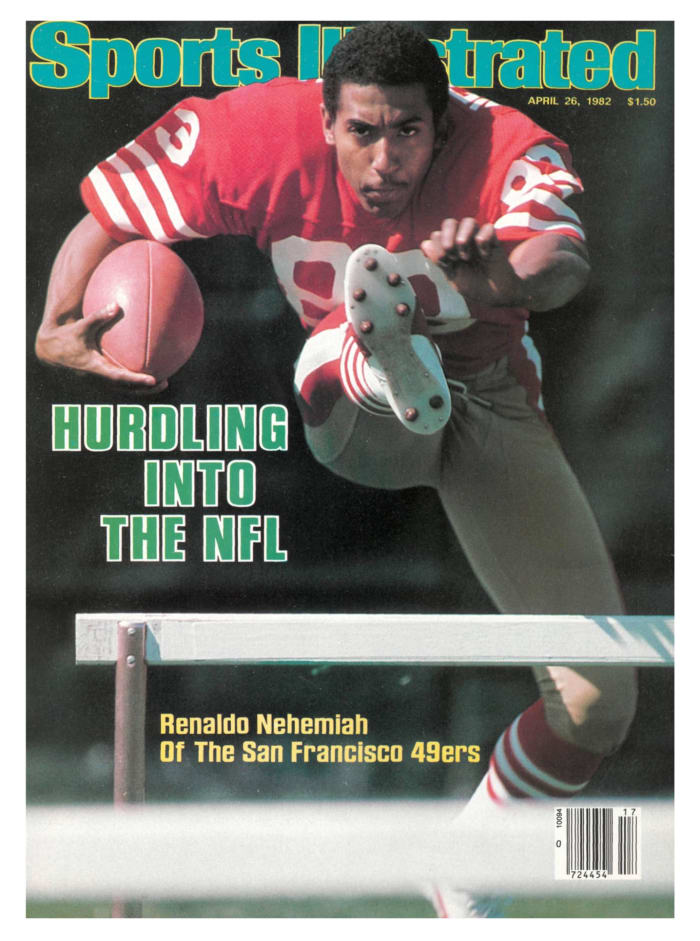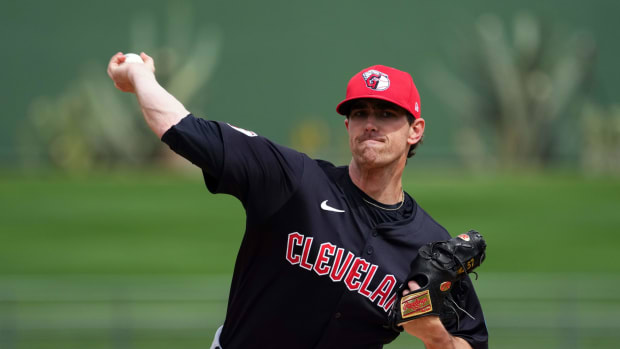SI:AM | The Mets Are Firing on All Cylinders
Good morning, I’m Dan Gartland. I’m upset I was on a plane and missed everyone dancing on the Nets’ grave.
In today’s SI:AM:
📈 The surprising best team in baseball
🏀 The surprising first team knocked out of the NBA playoffs
If you’re reading this on SI.com, you can sign up to get this free newsletter in your inbox each weekday at SI.com/newsletters.
A hot start in Queens
Don’t look now, but Mets fans might have reason for optimism this season.
After winning a wild game in St. Louis last night, the Mets have the most wins in baseball (13–5). They’ve won seven of their last nine and 10 of their last 13. And they’re not even at full strength.
The Mets’ win probability in last night’s game had dipped to 3% after Robinson Canó flew out to left in the ninth, leaving them down 2–0 with one out remaining. They were down to their last strike when Mark Canha hit a grounder to third, but Nolan Arenado sailed the throw over the head of first baseman Paul Goldschmidt and one run scored on the error.
A double by Jeff McNeil set New York up with runners on second and third as Dominic Smith came to the plate. Smith hit a sharp grounder down the first base line and Goldschmidt made a nice play to stop it, but Smith beat pitcher Giovanny Gallegos to the bag with a dive, allowing the tying run to score from third. McNeil was running on contact with two outs and hustled to score from second to give the Mets the lead.
Brandon Nimmo homered on the very next pitch (after a pitching change) to make it 5–2 in favor of the Mets, and Edwin Díaz shut the Cardinals down in the bottom of the ninth to secure the win.
Max Scherzer threw seven innings, allowing two hits and one walk while striking out 10. It was the kind of performance the team and its fans envisioned when he signed a three-year, $130 million contract. But part of what made the Scherzer acquisition so enticing was the prospect of pairing him with Jacob deGrom to form the most unhittable front end of a rotation in all of baseball. That hasn’t come to fruition yet because deGrom has started the season on the injured list with a stress reaction on his right scapula, but as Stephanie Apstein wrote last week, the Mets have done just fine without him:
“Scherzer has dominated hitters for almost 15 years, so his success does not surprise anyone. And New York felt it picked up a steadying force, both on and off the mound, with righty Chris Bassitt, whom it acquired from the A’s in March. Righty Carlos Carrasco is a solid mid-rotation starter. But righty Tylor Megill, pressed into service when deGrom went down, and lefty David Peterson, who slotted into the rotation when righty Taijuan Walker developed bursitis in his shoulder, have been revelations. Megill did not allow a run until his third start; Peterson still has not. [Ed. note: Peterson allowed one run over 5 2/3 innings the night Apstein’s story was published.] They say they feed off one another.”
And the Mets finally got some good news about deGrom. The team announced last night that his latest MRI showed “considerable healing” and that he has been cleared “to begin loading and strengthening of the shoulder.” He still hasn’t been cleared to throw, but this is an important next step. When he gets back, watch out.
The best of Sports Illustrated
When a truck was abandoned last summer on a course in Kennesaw, Ga., with two dead bodies in the bed, Gene Siller was the one who investigated. Because that’s where his life’s path took him, Brian Burnsed writes in today’s Daily Cover.
The Nets were swept by the Celtics, and Howard Beck writes that their struggles can be traced to Kyrie Irving’s decision to make himself ineligible for home games. … These NBA draft prospects are worth watching after they decided to return to college, Jeremy Woo writes. … Tom Verducci looks at Padres pitcher Yu Darvish and the MLB-wide trend of prioritizing spin over speed. … Unai Emery has struggled to fit in at some clubs but as manager of Villareal has turned the team into a Champions League giant slayer, Jonathan Wilson writes.
Around the Sports World
Donovan Mitchell injured his hamstring in the Jazz’s blowout loss to the Mavericks. … The Raptors easily handled the Sixers in Philly to avoid elimination again. Game 6 is Thursday in Toronto. … A former Suns employee pleaded guilty to fraud charges for selling 2,800 tickets on StubHub. … Phil Mickelson has asked the PGA Tour for permission to play in one of the Saudi golf league’s events. … Virginia’s attorney general will investigate the Commanders.
The top five...
… things I saw last night:
5. Ja Morant gifting his Most Improved Player award to Desmond Bane
4. Mike Trout’s hustle on this flukey triple
3. The extremely lucky basket that kept Matisse Thybulle from being held scoreless
2. Marcus Smart’s reaction to Kevin Durant’s garbage-time three
1. George Springer’s diving catch in center field
SIQ
Which team drafted John Elway with the No. 1 pick in the NFL draft on this day in 1983?
Yesterday’s SIQ: True or false: On April 25, 1974, the NFL moved the goalposts from the front of the end zone to the back for the first time.
Answer: False. While one of the rule changes approved by owners on April 25, 1974, was moving the goalposts to the rear of the end zone, it was the second time the NFL had made the switch.
As Emily Kaplan wrote for SI in 2017, the league had briefly experimented with deeper uprights for a few years before World War II.
“When the NFL was founded in 1920, it used the ‘H’ design for its uprights and placed them on the goal line. In 1927, the league moved the posts back 10 yards, to the back of the end zone. The reasoning? That’s what the NCAA did. At the time, the NFL simply followed the college rulebook. But that was short-lived. In 1933, the NFL finally wrote its own rulebook. And in an effort to increase field goal attempts—the general feeling was that there were too many ties—the NFL moved the uprights back to the goal line.”
The uprights stayed there until 1974, when owners voted to implement several rule changes designed to aid offenses. Some offensive penalties were reduced from 15 yards to 10 yards. Changes to the kickoff and punt rules were intended to lead to bigger returns. Defenders were prohibited from “chucking” receivers more than once on a given play. Moving the goalposts was a multifaceted change. Most simply, it was designed to reduce the number of field goal attempts (as kickers improved, the share of points scored on field goals had increased steadily). It also helped out quarterbacks who previously had to worry about hitting the goalposts with a pass, which was an automatic incompletion. But on the other side of the coin, moving the uprights out of the field of play benefited defenses by eliminating an obstruction offenses had grown accustomed to using as a blocker.
From the Vault: April 26, 1982
For decades, NFL teams have seen elite sprinters and thought, “What if we could teach him to play football?” I’m not talking about guys like Jeff Demps and Trindon Holliday, standouts on the track who also played college football. I’m talking about experiments like the Bengals signing 1968 Olympian Tommie Smith and the Eagles drafting John Carlos.
In 1982, the 49ers signed a hurdler named Renaldo Nehemiah to play wide receiver. Nehemiah was an NCAA champion at the University of Maryland and broke several world records. He would have competed at the Olympics in ’80 had the U.S. not boycotted the Games.
Nehemiah was disappointed to be denied the opportunity to introduce himself to a national audience but found another way to capture the spotlight: by competing in the made-for-TV athletic competition The Superstars. Here’s how John Papanek’s SI cover story recounted Nehemiah’s experience on the show in 1981:
“It was at the Superstars competition in Key Biscayne, Fla. last February that the football idea first took root. Nehemiah was wowing everyone, winning the half-mile bicycle race and holding his own in bowling and the half-mile run. In golf, a three-shot, closest-to-the-hole contest at about 150 yards, Nehemiah, who figures he has played the game only a dozen times, barely hit the ball on his first attempt. On the next, he nailed a nine-iron to within 13 feet of the hole, which proved to be the winning shot. In the obstacle course event, which he also won, he became one of the few competitors ever to vault the 12-foot wall without using a rope—he simply leapt, kicked with one foot, and was over. But it was his weightlifting that caused the greatest stir. He placed second, pressing 265 pounds, to Mark Gastineau, the 6'5", 280-pound defensive end for the New York Jets, who lifted 300.”
Gastineau and Cris Collinsworth asked Nehemiah if he had considered giving football a try, and Collinsworth gave him a crash course in route running the day after Nehemiah won the Superstars competition.
Nehemiah started preparing to make the leap to the NFL, but parts of it rubbed him the wrong way. For example, he was leaving behind a fairly lucrative career in track (as much as $200,000 a year, according to the article), and teams were giving him lowball offers. The Eagles offered only $35,000 ($113,000 today) for his first year.
“They act like they’re going to give me 10 dollars and I never had a penny before in my life,” Nehemiah told Papanek. “That I should be happy just to be allowed into pro football. What burned me most often was when they gave the impression that I wasn’t serious.”
But Nehemiah was serious, and so were the Niners. They signed him before the 1982 season and started putting him through specialized workouts ahead of training camp. If you compare him to any other undrafted receiver, Nehemiah’s NFL career wasn’t bad. After catching eight passes for 161 yards as a rookie, he had 17 catches for 236 yards and a touchdown in ’83 and 18 catches for 357 yards and two scores in ’84. He was cut before the ’85 season after the Niners drafted a guy named Jerry Rice and went back to running track professionally.
Check out more of SI’s archives and historic images at vault.si.com.




































